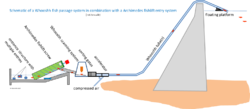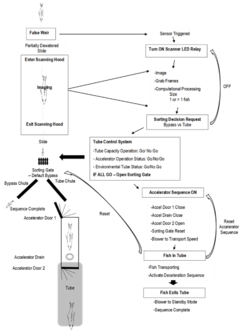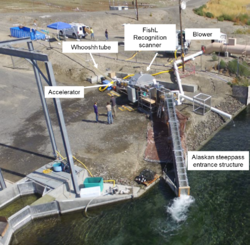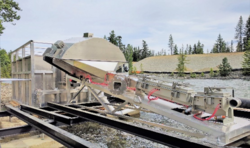Whooshh Fish Passage System (WFPS)
Contents
Quick summary
Developed by: Whooshh Innovations, Seattle
Date: July 1, 2019
Introduction
Upstream and downstream fish migration is among the main concerns regarding ecological sustainability of hydropower schemes. For small weirs and dams conventional approaches such as various types of fish passes or natural bypasses are available. However, upstream migration over dams higher than 20 or 30 m is considered technically unfeasible and too costly. The Whooshh fish passage system (WFPS) is an innovative and highly cost-effective method to enable upstream migration across dams of any height. The WFPS was designed using novel, innovative ecotechnology to allow autonomous, selective, volitional upstream fish passage over low and high head dams. The technology provides fish passage through the application of differential air pressure to glide the fish rapidly through a soft, flexible tube, with controlled deceleration and smooth exit. This provides safe, timely, efficient and effective fish passage.
The WFPS was originally developed and tested for Pacific Salmon, though the company has moved many species including trout, sturgeon, shad, sucker, bass and pike. Salmon are excellent swimmers and actively enter the WFPS through an Alaskan steeppass and pass over a false weir where they are partially dewatered and from where they slide into a scanner equipped with six cameras. For European rivers an alternative entry device was developed that uses a traditional entry structure, similar to other fishways, with multiple entrances, attraction flows etc. Once inside the entrance basin fish are drawn into an Archimedes screw-type fish lift which lifts the fish out of the river, the fish are partially dewatered as they then glide into the above-mentioned scanner. A modular approach to entrance design has been adopted to optimize versatility and fish passage success. Multiple modular entrance options exist, and additional options are continuing to be developed as well. The selection of the best modular entrance device for a given waterway will be dependent upon the local situation regarding topography and water levels, as well as to the different migrating fish species requiring upstream fish passage.
As the fish slides through the scanner, the fish is imaged, and artificial intelligence-based algorithm computations determine the size of the fish and the species. It can also differentiate between wild fish and hatchery fish if the adipose fin is removed from hatchery fish, and the company is continuing to develop algorithms to expand its species differentiation capabilities. These can be added as over-the-air updates to continually update the system’s capabilities. The system then determines if the fish is to be transported upstream in one of the installed tubes, taken into a holding tank or back into the tailwater area (e.g. for preventing invasive species to migrate upstream). This is done by a system of opening or closing gates that the fish slide through. The fish are not handled or detained, they just slide through as the entire process of scanning and sorting takes 1-2 seconds.
From the scanner and sorting system the fish glide into an accelerator where a gentle pressure difference of 0.1 bar is applied to move the fish into and through a soft, water mist- lubricated tube corresponding to the size of the fish. A variety of tube sizes are available. The fish move in the water-misted air with a velocity of approximately 5 meters per second along the tubes. A distance of several hundred meters can be overcome and dam heights up to 300 m can be crossed rapidly, with no slime loss or injury to the fish. At the end of the tube the fish are gently released into the headwater and can continue their upstream journey.
Application
The WFPS is a modular and highly flexible system. Using varying configurations of its modular componentry, the system can be adapted to every individual site. The design and particularly the entrance solution is selected to address the conditions of the local situation, upstream and downstream water levels and their fluctuations and to the fish species that are to be enabled to migrate or blocked from migration. In European rivers where typically many different species are abundant and they may vary in size and body shape, it is necessary to install several tubes with the capacity to move different sized fish to allow sorting and transportation according to the shape and size of the individual fish. The assembly of the WPFS with the Archimedes screw fish lift modular entry device ensures that all fish species, including bottom fish and poor swimmers, can actively enter the WFPS. The Archimedes screw fish lift has demonstrated its capability to lift fish over a range of lengths and all species tested so far. The WFPS also benefits fisheries restoration efforts in that adaptive management adjustments to varying situations may be continually employed, which is not possible with fixed methods such as ladders or fish lifts.
A WFPS can be installed within months rather than years and it is considerably less costly than comparable traditional fish ladders such as vertical slot passes. Given that the WFPS componentry has been designed to be modular, systems can be configured for varying species, entry situations and river conditions, all using standardized componentry. Expensive customization is thus avoided. WFPS systems can be land-based but also include floating options, so that complicated design/build and permitting may be streamlined. Since only negligible flows of water are used for the operation, it may even pay for itself in situations where no environmental flows must be released, e.g. in hydropower dams where the power house is at the bottom of the dam, or in situations where a ladder exists and is now no longer needed – the hydropower value of the extra waterpower realized can often more than cover the cost of the system.
Other information
To date >20 studies have been performed. These include evaluations of the effects of fish passage through the WFPS in comparison to passage through conventional systems such as vertical slot passes. The following aspects were investigated and no negative effects were detected:
- Short-term and long-term survival after WFPS passage
- Injuries and physiological stress
- Reproductive consequences (health of eggs)
- Energetic costs of migration
The results are published in peer-reviewed journals, governmental and internal reports. Study links and information can be found on the [Whooshh website], including links to several YouTube films.
In addition to being beneficial for migratory fish, the WFPS is beneficial to hydropower in that it provides an effective and cost-effective solution. The cost of the system depends on the site-specific needs characterized by the entrance modules chosen, the length of transport and the number and size range of species and therefore the complexity of the sorting system and the number of tubes. Still, since the WFPS features modular componentry of core features, the system provides economic value. Typically, the cost savings in comparison to a traditional, e.g. vertical slot, fish pass, can reach up to 80% (and can often be financed).
The operating and maintenance costs are composed primarily of maintenance of the components and the energy consumption for the high-volume blower and other components such as pumps when needed. In stand-by mode the system needs around 1 kW and as soon as a fish enters, the consumption rises to 20 kW. But that level of consumption is only needed for a few seconds until the fish has left the system. An energy cost per fish can therefore be calculated. On the other hand, the system requires hardly any water and therefore can be highly favourable and cost saving in comparison to a traditional fish ladder.
Relevant literature
- Geist DR, Colotelo AH, Linley TJ, Wagner KA, Miracle AL. 2016. Physical, physiological, and reproductive effects on adult fall Chinook Salmon due to passage through a novel fish transport system. Journal of Fish and Wildlife Management 7(2):1-16.
- Jorde K., Bryan J. (2020): Das Whooshh Fish Passage System für den Fischaufstieg an hohen Stauanlagen, Wasserwirtschaft 2/3 2020, in print.
- Mesa MG, Gee LP, Weiland LK, Christansen HE. 2013. Physiological responses of adult Rainbow Trout experimentally released through a unique fish conveyance device. North American Journal of Fisheries Management. 33(6): 1179-1183.
- Fryer J. 2017. Results of a PIT tag study at Priest Rapids Dam to assess the impact of the Whooshh Fish Transport System on upstream migrating Sockeye Salmon. (April 2019; http://www.ucsrb.org/science-on-the-street-february-2017/)
- Hansen W. 2015. Whooshh Volitional Entry. (April 2019; https://www.youtube.com/watch?v=bFj-Fj5-bPY)
- Whooshh. 2018. Whooshh Study Results. (April 2019; https://www.whooshh.com/studies.html)
Contact information
Whooshh Innovations Ltd
Representative for Europe and the Himalayan region:
Dr. Klaus Jorde
KJ Consult
Klagenfurt, Austria
Tel.+43 664 2429748
klaus.jorde@kjconsult.net
www.kjconsult.net



